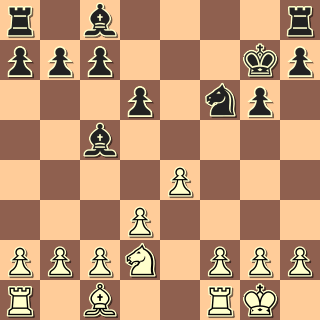Playing a 3-minute game often requires both players to put aside any thoughts of what moves they could have played, or should have mande, but didn't. With more time to reflect, such musings might help in forming future plans, but in blitz, they can haunt ongoing play.
BoomBoomTNT-YT - tyronev1
3 0 blitz, Chess.com, 2020
1.e4 e5 2.Nf3 Nc6 3.Bc4 Bc5 4.Bxf7+
4...Kxf7 5.Nxe5+ Nxe5 6.Qh5+ g6 7.Qxe5
Now, Black can choose Blackburne's Defense, 7...d6, or Whistler's Defense, 7...Qe7 - both are complicated and dangerous - or amongst a handful of lesser lines, e.g. 7...Bd6.
7...Qe7
8.Qd5+
We have recently taken a look at this infrequently- played move. See "Jerome Gambit: Largely Overlooked by History".
Recent alternatives:
8.Qxe7+ Kxe7 9.b3 a6 10.Bb2 Nf6 11.O-O Kf7 12.Nc3 Bd4 13.Rae1 Bxc3 14.Bxc3 d6 15.e5 dxe5 16.Bxe5 Rg8 17.Bxc7 Bg4 18.f3 Bh5 19.Bd6 Rad8 20.Bb4 g5 21.Re7+ Kg6 22.Rxb7 Rg7 23.Rb6 Rd4 24.Bc3 Rd8 25.Rxf6 checkmate, Ghigi,N - NN, 5 1 blitz, 2020;
8.Qxh8 Ke6 (8...Qxe4+ 9.Kd1 Qxg2 10.Qxh7+ Kf8 11.c3 Qxh1+ 12.Kc2 Qe4+ 13.d3 Qa4+ 14.b3 Qg4 15.Bh6+ Nxh6 16.Qxh6+ Kf7 17.Qh7+ Kf6 18.Nd2 Bxf2 19.Ne4+ Kf5 20.Qf7+ Ke5 21.Qf6+ Kd5 22.c4 checkmate, tomkoolen1996 - ThomasBovenkerk, 10 5 blitz, lichess.org, .com, 2020; or 8...Nf6 9.d3 b6 10.Bg5 Bd4 11.c3 Bb7 12.Bxf6 Bxf6 13.Qxh7+ Kf8 14.Qxe7+ Black resigned, Anonymous -Anonymous, 5 0 blitz, lichess.org, 2020) 9.Qxg8+ Kd6 10.Qd5 checkmate, decidueyemainbtw -MarcosEngenheiro, Chess.com 2020; and
8.Qf4+ Qf6 9.Qg3 Bd6 10.f4 Bxf4 11.Qb3+ Qe6 12.O-O Qxb3 13.Rxf4+ Kg7 14.axb3 d6 15.d4 Ne7 16.Nc3 Bd7 17.Be3 a6 18.Raf1 Rhe8 19.Rf7+ Kh8 20.Bg5 Nc6 21.Bf6+ Kg8 22.Rxd7 Black resigned, Wall,B - Guest744598, PlayChess.com, 2020.
8...Kg7
The text move looks a little bit better than 8...Kf8, which might place the King in the way of a Rook that wants to be developed, e.g. eronald - ayushsankar1006, 5 0 blitz, lichess.org, 2020 (0-1, 23).
8...Kg7
The text move looks a little bit better than 8...Kf8, which might place the King in the way of a Rook that wants to be developed, e.g. eronald - ayushsankar1006, 5 0 blitz, lichess.org, 2020 (0-1, 23).
9.d4 Bb4+
Not quite as strong as 9...Bb6, levigun - obviously, 5d + 2d GameKnot.com, 2004, (0-1, 11)
10.c3 Nf6 11.Qe5
White has to be careful, with only one piece developed vs three, even with his strong pawn center. Fortunately, Black helps him out.
11...Qxe5
Exchanging Queens in the Jerome Gambit if often a help to the defender. In this case - a 3-minute blitz game - Black has not looked deeply enough, however.
12.dxe5 Nxe4 13.cxb4 Re8
14.Nc3
A bit stronger was 14.0-0 Rxe5 15.Bf4 Re6 16.Bxc7. This possibility seems to haunt both player's thoughts during the next few moves, perhaps unconsciously.
14...Rxe5 15.O-O
Of course, White can not now play 15.Bf4 Re6 16.Bxc7 because of 16...Nxc3+.
15...d5 16.Be3
This is a solid move, although, again, 16.Bf4 was on.
16...c6
Black suddenly realizes that the 16.Bf4 skewer could win a pawn, so he moves that pawn to safety. But he overlooks something.
17.Bd4
Black resigned
The Rook is a goner.



































.png)

.png)
.png)
.png)
.png)

.png)
.png)
.png)
.png)
.png)